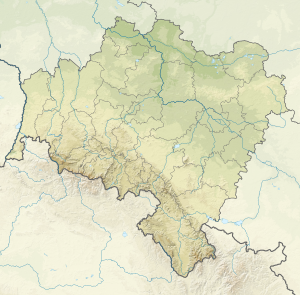Oels Castle
| Oels Castle | ||
|---|---|---|
|
Entrance area of the castle |
||
| Alternative name (s): | Zamek Oleśnica (pl.) | |
| Creation time : | around 1292 | |
| Castle type : | Höhenburg, hillside location | |
| Conservation status: | very good | |
| Standing position : | Knight's castle (fortress), rebuilt in the Renaissance style since the 16th century | |
| Construction: | Castle: granite fragments and gneiss, connected by lime mortar. | |
| Place: | Oleśnica , | |
| Geographical location | 51 ° 12 '32 " N , 17 ° 22' 35" E | |
| Height: | 300 m | |
|
|
||
The Oels castle is the largest Renaissance castle in Europe and a former possession of the Hohenzollern in Silesia.
history
The castle was built on the site of a Gothic fortress from the 13th century. The castle was first mentioned in 1292. Later extensions and reconstructions made it a Renaissance residence with modern fortifications. The oldest remaining part of the former Gothic building is the tower from the late 13th century. The castle was owned by the House of Württemberg in 1792 and then passed into the possession of the Welfs until 1884 . Then the Hohenzollern took over the dilapidated castle and renovated it thoroughly. After the First World War, the family was able to assert their property claims as part of the prince expropriation. The Crown Prince Wilhelm of Prussia used the castle with his wife as a summer residence. The horse-loving Crown Prince set up a Trakehner stud . After the Second World War, the castle was used as a prisoner-of-war camp for Hungarian and Italian soldiers and later as a branch of the Soviet International Red Cross. It was then used as a technical secondary school until the beginning of the 1970s. Then it was renovated again and served as a branch of the Archaeological Museum of Wroclaw. Since 1993 the Voluntary Labor Corps started its work there.

